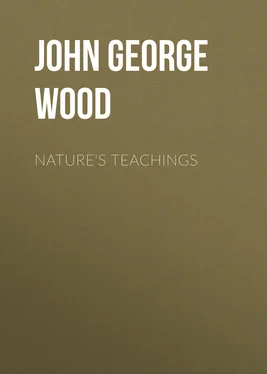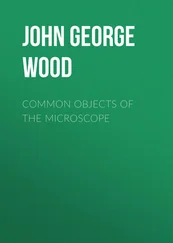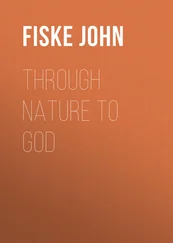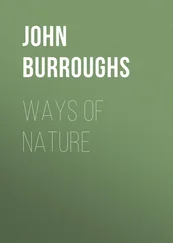John George Wood - Nature's Teachings
Здесь есть возможность читать онлайн «John George Wood - Nature's Teachings» — ознакомительный отрывок электронной книги совершенно бесплатно, а после прочтения отрывка купить полную версию. В некоторых случаях можно слушать аудио, скачать через торрент в формате fb2 и присутствует краткое содержание. Издательство: Иностранный паблик, Жанр: foreign_antique, Природа и животные, foreign_edu, на английском языке. Описание произведения, (предисловие) а так же отзывы посетителей доступны на портале библиотеки ЛибКат.
- Название:Nature's Teachings
- Автор:
- Издательство:Иностранный паблик
- Жанр:
- Год:неизвестен
- ISBN:нет данных
- Рейтинг книги:5 / 5. Голосов: 1
-
Избранное:Добавить в избранное
- Отзывы:
-
Ваша оценка:
- 100
- 1
- 2
- 3
- 4
- 5
Nature's Teachings: краткое содержание, описание и аннотация
Предлагаем к чтению аннотацию, описание, краткое содержание или предисловие (зависит от того, что написал сам автор книги «Nature's Teachings»). Если вы не нашли необходимую информацию о книге — напишите в комментариях, мы постараемся отыскать её.
Nature's Teachings — читать онлайн ознакомительный отрывок
Ниже представлен текст книги, разбитый по страницам. Система сохранения места последней прочитанной страницы, позволяет с удобством читать онлайн бесплатно книгу «Nature's Teachings», без необходимости каждый раз заново искать на чём Вы остановились. Поставьте закладку, и сможете в любой момент перейти на страницу, на которой закончили чтение.
Интервал:
Закладка:
J. G. Wood
Nature's Teachings / Human Invention Anticipated by Nature
PREFACE
A GLANCE at almost any page of this work will denote its object. It is to show the close connection between Nature and human inventions, and that there is scarcely an invention of man that has not its prototype in Nature. And it is worthy of notice that the greatest results have been obtained from means apparently the most insignificant.
There are two inventions, for example, which have changed the face of the earth, and which yet sprang from sources that were despised by men, and thought only fit for the passing sport of childhood. I allude, of course, to Steam and Electricity, both of which had been child’s toys for centuries before the one gave us the fixed engine, the locomotive, and the steamboat, and the other supplied us with the compass and the electric telegraph.
In the course of this work I have placed side by side a great number of parallels of Nature and Art, making the descriptions as terse and simple as possible, and illustrating them with more than seven hundred and fifty figures. The corollary which I hope will be drawn from the work is evident enough. It is, that as existing human inventions have been anticipated by Nature, so it will surely be found that in Nature lie the prototypes of inventions not yet revealed to man. The great discoverers of the future will, therefore, be those who will look to Nature for Art, Science, or Mechanics, instead of taking pride in some new invention, and then finding that it has existed in Nature for countless centuries.
I ought to mention that the illustrations are not intended to be finished drawings, but merely charts or maps, calling attention to the salient points.
NAUTICAL
CHAPTER I
Poetry and Science.—The Paper Nautilus and the Sail.—Montgomery’s “Pelican Island.”—The Nautilus replaced by the Velella.—The Sailing Raft of Nature and Art.—Description of a Velella Fleet off Tenby.—The Natural Raft and its Sail.—The Boats of Nature and Art.—Man’s first Idea of a Boat.—The Kruman’s Canoe and the Great Eastern .—Gradual Development of the Boat.—The Outrigger Canoe a Mixture of Raft and Boat.—Natural Boats.—The Water-snails.—The Sea-anemones.—The Egg-boat of the Gnat.—The Skin-boat of the same Insect.—Shape and Properties of the Life-boat anticipated in Nature.—Natural Boat of the Stratiomys.
IT has been frequently said that the modern developments of science are gradually destroying many of the poetical elements of our daily lives, and in consequence are reducing us to a dead level of prosaic commonplace, in which existence is scarcely worth having. The first part of this rather sweeping assertion is perfectly true, but, as we shall presently see, the second portion is absolutely untrue.
Science has certainly destroyed, and is destroying, many of the poetic fancies which made a part of daily life. It must have been a considerable shock to the mind of an ancient philosopher when he found himself deprived of the semi-spiritual, semi-human beings with which the earth and water were thought to be peopled. And even in our own time and country there is in many places a still lingering belief in the existence of good and bad fairies inhabiting lake, wood, and glen, the successors of the Naiads and Dryads, the Fauns and Satyrs, of the former time. Many persons will doubtless be surprised, even in these days, to hear that the dreaded Maelström is quite as fabulous as the Symplegades or Scylla and Charybdis, and that the well-known tale of Edgar Poe is absolutely without foundation.
Perhaps one of the prettiest legends in natural history is that of the Paper Nautilus, with which so much poetry is associated. We have all been accustomed from childhood to Pope’s well-known lines beginning—
“Learn of the little Nautilus to sail,”
and some of us may be acquainted with those graceful verses of James Montgomery, in his “Pelican Island:”—
“Light as a flake of foam upon the wind,
Keel upward, from the deep emerged a shell,
Shaped like the moon ere half her horn is filled.
Fraught with young life it righted as it rose,
And moved at will along the yielding water.
The native pilot of this little bark
Put out a tier of oars on either side,
Spread to the wafting breeze a two-fold sail,
And mounted up and glided down the billow
In happy freedom, pleased to feel the air,
And wander in the luxury of light.
* * * * *
It closed, sank, dwindled to a point, then nothing,
While the last bubble crowned the dimpling eddy
Through which mine eye still giddily pursued it.”
So deeply ingrained is the poetical notion of the sailing powers attributed to the nautilus, that many people are quite incredulous when they are told that there is just as much likelihood of seeing a mermaid curl her hair as of witnessing a nautilus under sail. How the creature in question does propel itself will be described in the course of the present chapter; and the reader will see that although one parallel between Nature and Art in the nautilus does not exist, there are several others which until later days have not even been suspected.
It is, therefore, partially true that science does destroy romance. But, though she destroys, she creates, and she gives infinitely more than she takes away, as is shown in the many late discoveries which have transformed the whole system of civilised life. Sometimes, as in the present instance, she discovers one analogy while destroying another, and though she shatters the legend of the sailing nautilus, she produces a marine animal which really does sail, and does not appear to be able to do anything else. This is the Velella, a figure of which, taken from a specimen in my collection, is given in the illustration, and drawn of the natural size.
It is one of that vast army of marine creatures known familiarly by the name of “jelly-fishes,” just as lobsters, crabs, shrimps, oysters, whelks, periwinkles, and the like, are lumped together under the title of “shell-fish.” As a rule, these creatures are soft, gelatinous, and, in fact, are very little more than sea-water entangled in the finest imaginable mesh-work of animal matter; so fine, indeed, that scarcely any definite organs can be discovered. The Velella, however, is remarkable for having a sort of skeleton, if it may be so called, consisting of two very thin and horny plates, disposed, as shown in the illustration, so as to form an exact imitation (or perhaps I should say a precursor) of a raft propelled by a sail. Indeed, the Latin name Velella signifies a little sail.
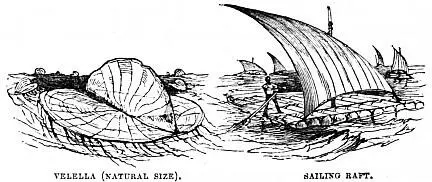
How well deserved is the name may be seen by the following graphic account of a Velella fleet sent to me by a lady who takes great interest in practical zoology:—
“The specimens which I send came from Tenby, a very rough sea having driven a large living fleet of them on that coast.
“When in life, they are semi-transparent, and radiant in many rainbow-tinted colours. They came floating towards me in all their fragile beauty on the rough sea waves. I succeeded in capturing some of them, and preserved the only portion available for my collection.
“They are extremely tender, and by no means with which I am acquainted can be preserved more than these skeleton-like cartilaginous plates. They soon dissolve in either spirits of wine or water, and lose every vestige of their shape and substance. The upright, thin, pellucid plate has the appearance of a fairy-like miniature sail, and apparently acted as such when the creature was floating with its long and many-tinted tentacles pendent from its lower surface.
Читать дальшеИнтервал:
Закладка:
Похожие книги на «Nature's Teachings»
Представляем Вашему вниманию похожие книги на «Nature's Teachings» списком для выбора. Мы отобрали схожую по названию и смыслу литературу в надежде предоставить читателям больше вариантов отыскать новые, интересные, ещё непрочитанные произведения.
Обсуждение, отзывы о книге «Nature's Teachings» и просто собственные мнения читателей. Оставьте ваши комментарии, напишите, что Вы думаете о произведении, его смысле или главных героях. Укажите что конкретно понравилось, а что нет, и почему Вы так считаете.
